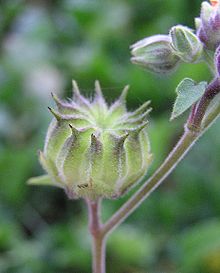- Abutilon theophrasti
-
Abutilon theophrasti 
Scientific classification Kingdom: Plantae (unranked): Angiosperms (unranked): Eudicots (unranked): Rosids Order: Malvales Family: Malvaceae Genus: Abutilon Species: A. theophrasti Binomial name Abutilon theophrasti
Medik.Synonyms - Abutilon abutilon (L.) Rusby
- Abutilon avicennae Gaertn.[1]
Abutilon theophrasti (Velvetleaf, China Jute, Buttonweed, Butterprint, Pie-marker or Indian Mallow) is an annual plant in the family Malvaceae, native to southern Asia. It grows to 1 m tall, and has velvet-like heart-shaped leaves 15–25 cm broad. The flowers are yellow or orange, 4 cm diameter, maturing into button-shaped capsules which split lengthwise to release the seeds. The flowers and plants have a fruity scent.
Velvetleaf grows primarily in cropland, especially corn fields, and it can also be found on roadsides and in gardens.[2] Velvetleaf prefers rich and cultivated soils, such as those used in agriculture.
Contents
Cultivation and uses
Velvetleaf has been grown in China since around 2000 BCE for its strong, jute-like fibre. The leaves are edible, stir-fried or in omelette. The seeds are eaten in China and Kashmir.[3]
Invasive species
In midwestern and northeastern regions of the United States, eastern Canada and the Eastern Mediterranean, A. theophrasti is considered a damaging weed to agricultural crops, especially corn and soybeans.[4]
Since being introduced to North America in the 18th century, velvetleaf has become an invasive species in agricultural regions of the eastern and midwestern United States. It is one of the most detrimental weeds to corn causing decreases of up to 34% of crop yield if not controlled and costing hundreds of millions of dollars per year in control and damage. Velvetleaf is an extremely competitive plant, so much so that it can steal nutrients and water from crops.[5] Velvetleaf is controllable by herbicides.
References
- ^ "Abutilon theophrasti". Integrated Taxonomic Information System. http://www.itis.gov/servlet/SingleRpt/SingleRpt?search_topic=TSN&search_value=21674. Retrieved January 26, 2008.
- ^ Richard H. Uva, Joseph C. Neal and Joseph M. Ditomaso, Weeds of The Northeast, (Ithaca, NY: Cornell University Press, 1997), p. 256-257
- ^ "Velvetleaf". Written Findings of the State Noxious Weed Control Board - Class A Weed. February 2000. http://www.nwcb.wa.gov/weed_info/Written_findings/Abutilon_theophrasti.html.
- ^ Hameed A. Baloch, Antonio DiTommaso and Alan K. Watson. "Intrapopulation variation in Abutilon theophrasti seed mass and its relationship to seed germinability". Seed Science Research (2001) 11, 335–343. http://www.css.cornell.edu/WeedEco/Published%20Seed%20Sci%20Res.%2011%20335-343.pdf.
- ^ Davis, K. Renner, C. Sprague, L. Dyer, D. Mutch (2005). Integrated Weed Management. MSU
External links
Categories:- Abutilon
- Invasive plant species
- Flora of Pakistan
- Flora of North Dakota
Wikimedia Foundation. 2010.
